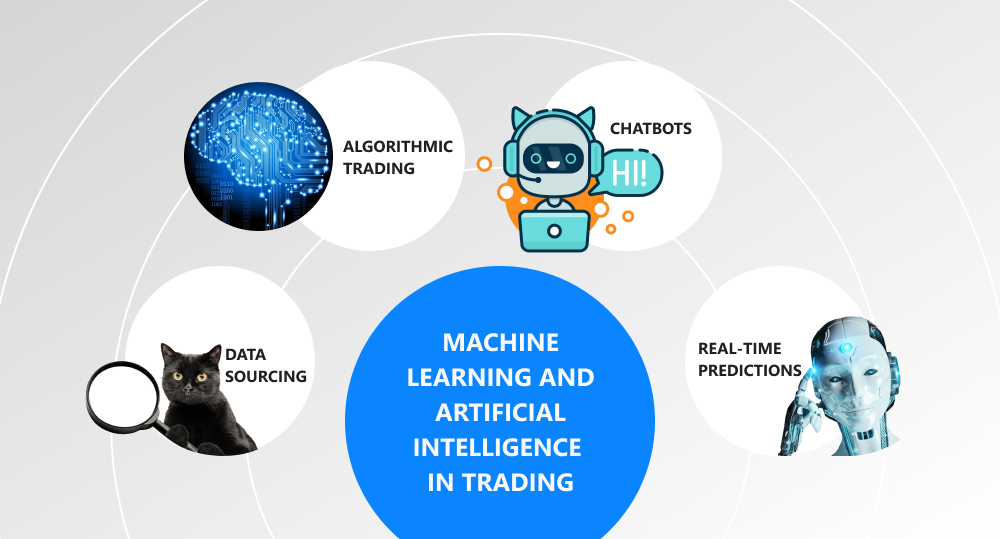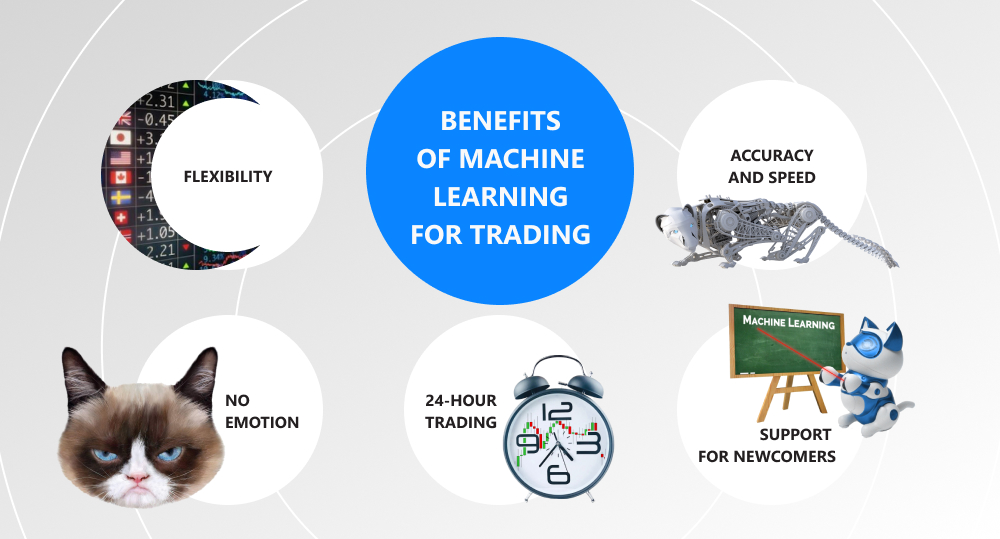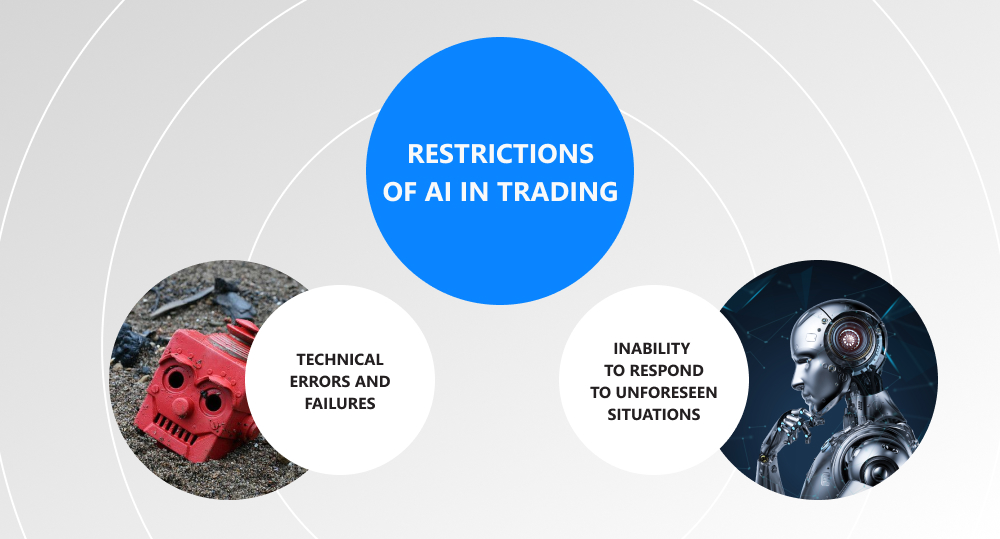Right off the bat, we have some statistics for you: the global machine learning (ML) market stood at $15.44 billion in 2021. It was predicted to reach $21.17 billion in 2022 and $209.91 billion by 2029. Such rapid growth isn’t surprising: artificial intelligence (AI) and machine learning techniques reshape many industries, including healthcare, IT, finance, marketing, and many more. Trading machine learning algorithms specifically automate trading sessions, build trading strategies, determine the price, time, and volume of transactions, predict future values, and perform a set of other tasks that make the trading process more efficient and simple.
In this article, we invite you to discuss the application of artificial intelligence and machine learning for trading. Will expert advice software and algorithmic trading replace human traders?
written by:
Alexander Sliborsky
Head of R&D and Innovations
According to Fortune Business Insights, the global machine learning (ML) market stood at $15.44 billion in 2021. It is expected to grow to $209.91 billion by 2029 from $21.17 billion in 2022. Today, artificial intelligence (AI) and machine learning techniques are used in many areas, such as medicine, finance, industry, and much more. For example, trading machine learning algorithms automate trading sessions, build trading strategies, determine the price, time, and volume of transactions, predict future values, and do other things to simplify and quicken the trading process. Let's talk about the application of artificial intelligence and machine learning for trading. Will expert advice software and algorithmic trading replace human traders?
Contents
Trading Workflow in Detail
First, let's understand what trading is and how it works. Simply put, this is the process of buying and selling assets (for example, securities, currencies, cryptocurrencies, commodities, and so on) in accordance with one's own forecasts for a change in the stock market conditions. All traders are aiming at developing a profitable trading strategy and gaining success in the market.
Let's say you are trading currency pairs and you expect the value of the dollar to rise against the euro. You buy dollars, and when their price rises, you sell it at the peak of quotes. As a result, you earn on the difference between the purchase price and the sale price. Other assets are traded according to the same rule. The trader should guess how the market will behave in response to any external factors, such as political events, financial news, economic sanctions, natural disasters, and even Elon Musk's tweets.
To make money on trading, the market participants must always keep their fingers on the pulse and analyze the market data, taking into account not only current events and news but also charts and technical indicators. Therefore, a trader must remain calm and get rid of unnecessary doubts and worries about possible losses. It's extremely important to track and analyze all relevant information. But a person gets emotional and often makes mistakes, following the crowd, as well as succumbing to panic or unjustified risk. Solutions based on artificial intelligence, machine learning, natural language processing, and deep learning techniques can help people successfully trade their assets.
Application of Machine Learning and AI in Trading
According to IHS Markit, the impact of the use of AI by financial institutions could reach $300 billion in 2030. As mentioned above, there are many factors that traders need to consider. They include news, historical data, reports, and so on. However, humans can't bear everything in mind. A machine learning algorithm, in turn, can easily process tons of information, identify patterns and anomalies, look for alternative data sources, and make predictions.
By the way, traders have long been using trading advisors or mathematical algorithms that can predict the behavior of your assets with high accuracy. This process is called algorithmic trading, which works according to certain algorithms. By developing trading strategies driven by AI and machine learning, the market participants have more chances to make the right trading decisions and complete a profitable transaction. Why? To answer this question, let's see how you can leverage AI and machine learning for trading:
Data Sourcing
To successfully trade in the stock markets, traders actively use various analytical charts, price data, and other indicators. It requires them to spend a lot of time and effort to find relevant information since the volumes of digital data is growing. According to Statista, global data creation is expected to reach more than 180 zettabytes by 2025.
However, trading software based on artificial intelligence and machine learning is not afraid of data structure complexity and rapidly growing volumes. ML algorithms help traders quickly extract signals from data and use them to make decisions on their own experience and knowledge.
Consider this: trading decisions are frequently shaped by news, social media updates, and other textual information. Natural Language Processing (NLP) empowers traders to extract actionable insights from unstructured text. For instance, it can detect significant events (mergers, acquisitions, regulatory changes) and assess their impact on stock prices. By processing this data, traders can react swiftly to breaking news.
Algorithmic Trading
Forecast and Predictive Models
Improvements in model accuracy.
Strategy Backtesting
One of the ways to test trading strategy is to apply it to historical data sample, this process is called backtesting. ML-based approaches could provide high-quality synthetic data to improve backtesting.
Reinforcement Learning
Lately, there were promising applications of Reinforcement Learning-based algorithms for trading strategies. In this case, the trading strategy is formulated through the agent which takes actions in a predefined environment in order to maximize the notion of total reward.
Chatbots
Natural Language Processing rapid advancements in recent years improve chatbots abilities. Traders can easily ask chatbot for different information and quickly get valuable reference information which will take into account the context of the question and previous requests as well.
Real-Time Predictions
When we check out the economic and financial news, assess the state of the markets, and analyze the statements of leading politicians and economists, we can make predictions that may turn out to be wrong. Humans can easily miss a detail that will be critical and adversely affect the trading process. A tiny mistake can lead to huge losses. Machine learning algorithms can build forecasts, find patterns and anomalies, and generate their own predictions in real-time to help the financial market participants make deals quickly and efficiently. Also, artificial intelligence can combine several forecasts and improve them.
Benefits of AI Trading
JP Morgan revealed that more than 60% of transactions over $10M were made using machine learning. Let's see why market participants apply ML and AI solutions for trading.
No Emotion
Many novice traders mistakenly believe that they need only the trading strategy and technical analysis to make a profit. But they forget about the key factor that affects the trading process. It's the ability to control emotions that significantly affect the results. Humans experience fear, greed, frustration, panic, despair, self-confidence, passion, and so on. These emotions cause the trader to deviate from the trading strategy and fail.
Algorithmic trading eliminates the human factor because algorithms operate solely according to the rules of the trading strategy on which they are based. Artificial intelligence won't panic or take unnecessary risks when making trading decisions. According to Gartner, investors will rely on artificial intelligence and data science when trading by 2025.
24-Hour Trading
A person needs healthy sleep and rest in order to be able to fully live and work. It's believed that humans should sleep 7-8 hours to stay healthy, feel good, and be able to think sensibly. By not being able to make sober decisions, a trader may miss out on profitable trades or relevant news and events. Machine learning algorithms don't need sleep. They can work day and night without getting tired or resting. The robot is ready to open a profitable deal at any time of the day when you're still in bed.
Support for Newcomers
Robots make life easier for beginners who are taking their first steps in trading. A novice trader doesn't have sufficient knowledge in the field of fundamental analysis, pricing, trading strategy development, and so on. Also, beginners don't know how to control emotions, and as a result of which they miss profitable deals and lose money.
Accuracy and Speed
Machine learning and deep learning algorithms work according to a strictly specified order of actions that are set by the developers. They don't allow human errors, such as putting an extra figure or a comma. AI and ML-based software can quickly react to changes in the market, analyze the state of the market, and open several transactions at the same time, which will allow you to increase your potential profit.
Flexibility
The trader usually works with 1-2 currency pairs and uses a few technical analysis tools since it will be difficult for him/her to deal with numerous assets or an unlimited number of indicators. Artificial intelligence, on the contrary, easily processes a lot of currency pairs and uses an unlimited number of technical indicators, greatly expanding the opportunities for earning.
Trading Machine Learning: Restrictions
In addition to the advantages, algorithmic trading has some drawbacks that should be taken into account.
Technical Errors and Failures
In 2012, the large American hedge fund Knight Capital lost almost $500 million due to a technical error. Old and new versions of the code were launched simultaneously and the algorithm began to perform unprofitable operations. Since then, the stock market participants have begun to use artificial intelligence to avoid such situations. There are AI models for detection of anomalous behavior. Nevertheless, traders should always remember about possible technical faults and rely only on their experience and intuition.
Inability to Respond to Unforeseen Situations
No matter how smart a robot is, it's not a human being. The algorithm can make a mistake in a non-standard situation. For example, during the coronavirus pandemic, many macro indicators changed, which caused the AI model based on the machine learning method to make erroneous decisions. The Bank of England found that 35% of banks experienced negative consequences because of this.
The vast majority of trading algorithms are based solely on technical analysis tools. Robots can process historical data and perform complicated calculations. Unlike people, they can't analyze fundamental factors, economic and political news, events in the country, influencers' statements, and so on.
Bottom Line
It's impossible to imagine trading without machine learning algorithms and artificial intelligence nowadays. Trading advisors perform millions of transactions per day. Applying algorithmic trading strategies allows traders to seize the opportunities that appear only for short periods of time.
Unlike humans, artificial intelligence can quickly process huge amounts of data, including tweets, news, financial indicators, and more. They help AI and ML-based trading solutions understand global trends and constantly improve their predictions about the financial markets. For example, Eurekahedge surveyed 23 hedge funds using artificial intelligence and found that robots gave much better results than funds managed by people. That's why many institutions engaged in trading began to use AI and machine learning models.
Looking for ways and developers to create trading solutions driven by artificial intelligence and machine learning? At Qulix, we are ready to consult you about the machine learning trading algorithms and answer all your questions. For more details, please visit our website or get in touch with our support team.

Contacts
Feel free to get in touch with us! Use this contact form for an ASAP response.
Call us at +44 781 135 1374
E-mail us at request@qulix.com








